
Part #02 of the MirrorBot Demo Video
** Video Installation Audio Visual Special Event n8 @Tacheles 17.12.2010
** Details of the Controller device:
- Programs and Live Mode LCD screen interface
Part #01 of the Video, Installation in MIKZ, Berlin 03.2010: /2011/01/03/mirrorbot-video-moving-projections-in-action
Technical details: lab.synoptx.net/mirrorbot
 Arduino, Bots, Event, Live Visuals, MirrorBot
Arduino, Bots, Event, Live Visuals, MirrorBot
 animation, Arduino, Demo Video, DiY, Event, Hardware, MirrorBot, Party, Programming, S65-shield, Servo Control, Visuals, VJ
animation, Arduino, Demo Video, DiY, Event, Hardware, MirrorBot, Party, Programming, S65-shield, Servo Control, Visuals, VJ

Demo Video of the “moving projection” video installation at Suchtfaktor elekto party in MIKZ, Berlin 03.2010
Monthly, every 1. saturday, also in 2011!
The “MirrorBot” is a Arduino minicomputer system to control the position of videobeamer projections. Two servomotors move a mirror in X- and Y- axis, which reflects the beamer image. The servos are controlled by a micro-controller with an LCD. It can play various movement pattern programs automatically, adjusted to the music speed by setting BPM or ‘live’ with the joystick and button.
Headsquatter VJs use it to move visuals around the whole dance floor when playing in clubs. Moving projections become a live instrument! 😀
more info in older posts :
lab.synoptx.net/2010/03/13/mirrorbot-v3-in-action
Music by droidsystem.com many ThanX!!

Here is a video about the PONGuino game for 2 players on a minicomputer with mobile-phone display and joysticks.
The box contains an Arduino 2009, a S65-LCD Shield and a gamepad from an old playstation 1. It runs autonomous on 9V battery.
The device is originally built for the “Mirrorbot” moving projection system [ lab.synoptx.net/mirrorbot ], but the pong-game-code from www.codetorment.com was perfect to test the LCD and – really – it’s fun to play!
The system is just fast enough to play a game, but you have to take care, how many pixels and how fast you draw. There is no double buffering and just a serial line between arduino and screen……
Sorry for the low quality photo-cam recording.
The LCD is not bad in reality: You don’t see the pixels and the scratches are only on a transparent folie..
Today the Headsquatter.org VJ crew plays two live video performances with multiple projections
Moving projections at Drachenspielplatz Schreinerstrasse or in Samariterstrasse – 20h-22h
-.
.-
Minimal electro 23:59h – late
-.
.-
headsquatter.org
youtube.com/headsquatter
myspace.com/headsquatter
-

-
SuppeMucke Plakat
-

-
SuppeMucke Plakat Bands
-
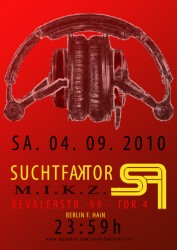
-
Suchtfaktor 4.9.20 Flyer
-

-
Suchtfaktor 4.9.20 Flyer
Come, have a look!
Who is interested to join the next Arduino talk & workshop in Berlin F’Hain?- please comment or mail
Workshop Info

Sensor forest on a breadboard
Hardware Hacking -DiY- Faderboxes & Robots — Introduction to Hardware <-> Software Interaction
This introduction is intended for anyone interested in (easy) electronics hardware and (mostly easy) software coding. Artists / *Designers & Hackers of all kinds are invited to join the FREE sessions in Berlin Friedrichshain.
We will introduce the Arduino plattform and show some practical examples. Basics of electronics and some interesting components will be explained shortly, but there are no tricky mechanical works and no soldering and not so complicated electro-technically theories involved.
We will focus on software programming inside the Arduino editor to show how to read analog values from various sensors and output to LEDs and servo motors.
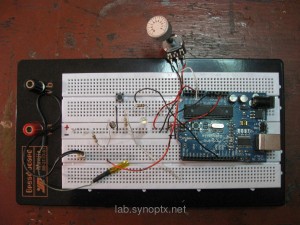
Big breadboard, many sensors + Arduino
To get some interesting visual results, we will use Processing to display incoming values from sensors in various,graphical ways.
After the lesson, you should have an idea how to design & build your own simple robots (servo motors…) or sensoric controllers (MIDI / OSC faderboxes,..). We can focus on special topics (maybe MIDI Controllers) in a follow up workshop.
Synoptx Crew organizes all material, tools and a nice location.
BYO laptop and Arduino or contact us to join a collective order of electronic parts!

Flash! People on the dancefloor - Mirror Station besides the DJ and the controller box in front
Headsquatter VJ crew used the new version of the moving-projections-robot in MIKZ club in Berlin Friedrichshain @
Suchtfaktor Party 6.3.2010
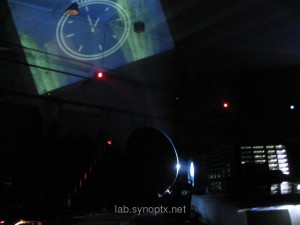
Mirror Station directing the beamer projection on wall and roof
to create a visuals show with a moving projection.
The 2D (X+Y axis) mirror-station was mounted in front of a 2500 ANSI lumen beamer – this was strong enough to produce very clear and big projections everywhere in the dancehall.
Two servo motors are driving one mirror in X- *and* Y- axis. The projection can be moved across the walls by a joystick or with automatic pattern programs, synced on beat of the music.
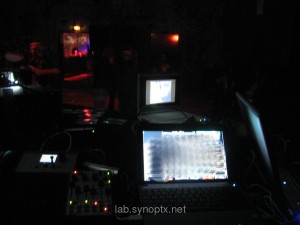
VJ desk: 2 video notebooks, 1 video-mixer, eeePC 701 preview screen, midi controller and mirrorbot controller
30° in vertical Y axis are enough to reach almost any point on the ceiling. Combined with more than 120° on the horizontal axis, it can project on any point on 3 of the walls.
Many guests on the dancefloor were surprised by the projections suddenly appearing and disappearing and when they discovered the mirror-station, they showed it to others. Some people came on stage to the VJ desk to ask how the moving projection works and some more came up to say that they liked the visuals show 🙂
It was fun to “play” the robot just like an instrument with the joysticks. When the positioning button is pressed on beat – matching to the rhythm – the projection is “dancing” across the room!
 Arduino, Bots, Event, General, Live Visuals, MirrorBot, Video
Arduino, Bots, Event, General, Live Visuals, MirrorBot, Video
 Arduino, Event, MirrorBot, Party, S65-shield, Servo Control, Visuals, VJ
Arduino, Event, MirrorBot, Party, S65-shield, Servo Control, Visuals, VJ

PONGuino game on the MirrorBot v3 Hardware
I wanted a playable game to show the possibilities of the Arduino plattform in workshops. Since I already have a S65-Shield built in a box with two joysticks, I wanted to use that MirrorBot hardware for presentation.
The most funny code I could find for the S65 Shield was a Pong game by
www.codetorment.com
This mod uses one axis of two joysticks – or two potis connected to input pins to move the two bats of the two players up and down.
The AI and encoder codes were removed and replaced by a similar check:
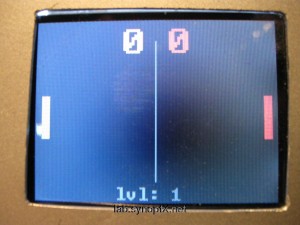
PONGuino 2 players in action
If the joystick potis are moved up or down, they decrease or increase the y position value of the matching bat.
If you have a s65 shield and would like to run this code, you could connect two potis to input pins (e.g. 0,1) and try those. Thes bats ‘should’ move, if you move the pots out of the center position.
I included a veeery simple level system:
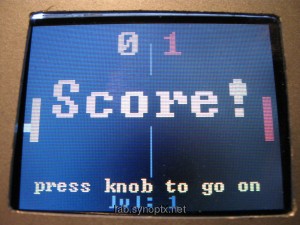
PONGuino someone got a point +
After each round a level int variable gets increased. This level var decreases a delay() (starting at 10 ms) in the main loop -that way, so the game gets faster, the more rounds you play ( 5 times).
🙂
….
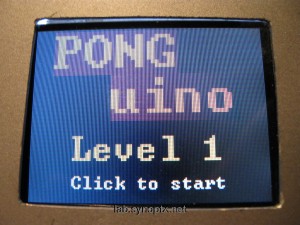
PONGuino game intro screen
Continue reading 'PONGuino – Arduino & S65 Shield – 2 Player MiniGame'»
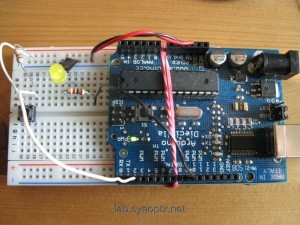
prototyping breadboard with Arduino backpack
On 28.1.2010 we had our first workshop to introduce the Arduino Microcontroller plattform in Berlin, FHain.
The session took place in Sama32 cafe and there were ~10 nerds, who were interested in micro-controllers and electronics. We presented some hardware and sketches and introduced the connection from arduino inputs to processing sketches.
Thanx to Todbot for the possibility to use his excellent slides!
Who is interested to join the next workshop?
Workshop Info
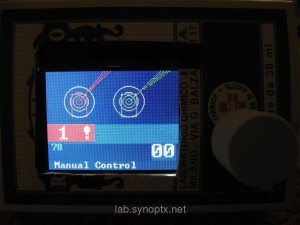
S65 Shield italian nosespray pappcarton prototype
We ordered a S65 Arduino shield from Watterott.com.
Simply plug it on a Arduino and play with a 176 x 132 pixels color display from a Siemens S65 handy, micro SD card slot and rotary encoder.
There is a library on the Watterott website, which contains some graphic functions to paint on the screen, just like in many other languages. This is enough to create small games, animations and GUIs in full color.
The refresh rate is not soo high, but its fast enough to paint moving objects and interactive animations. The painted pixels stay as they are until something else is drawn over – they do not need to be refreshed.

Testing to paint circles + lines and text
Instead, the screen must be completely cleared before redraw, which is veeeery slow or parts of the screen must be painted over with the background color.
After some experiments, I call the painting functions two times: 1. with the background-color – to overwrite exactly the previously painted lines with the background color, before re-painting moved objects. This approach works fast and the refresh is invisible.
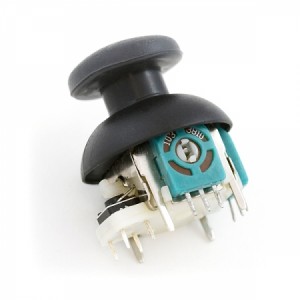
New Thumbstick
Do you have an old analog PS1 / 2 controller or a PC joypad? Or an used joystick with the old soundcard connector?
They work great as inputs for an Arduino! In fact, they are just two potentiometers, mounted on two axis.
When you open the case, you probably will find the potis mounted on a board, which includes all necessary connections. If you are lucky, you can use the existing cables on that board:
- 2 outer pins of each poti are connected to + and – 5V
- center pin changes voltage, depending on poti- resistance / position
Simply connect the power circuit to Arduino +/- voltage pins and the center pin to one analog input and analogRead() will read the values almost like a poti:
- center position: ~ 500
- full down: ~0
- full up: ~1023
The potis are often not so accurat, but you can easily implement some tolerance in software,
if the values are too much shaking
Code:
int potPinX = 1;
int potPinY = 2;
int valueX = 0;
int valueY = 0;
void setup() {
Serial.begin(9600); // setup serial
}
void loop() {
valueX = analogRead(potPinX);
valueY = analogRead(potPinY);
Serial.println(valueX);
Serial.println(valueY);
}
.. and you have the X /Y axis values stored in variables.
+ output to serial console via USB for debugging.



















